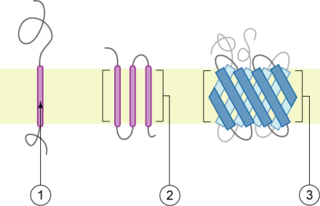Solute carrier family 17 (organic anion transporter), member 3 is a protein that in humans is encoded by the SLC17A3 gene. [5]
Solute carrier family 17 (organic anion transporter), member 3 is a protein that in humans is encoded by the SLC17A3 gene. [5]
The protein encoded by this gene is a voltage-driven transporter that excretes intracellular urate and organic anions from the blood into renal tubule cells. Two transcript variants encoding different isoforms have been found for this gene. The longer isoform is a plasma membrane protein with transporter activity while the shorter isoform localizes to the endoplasmic reticulum. [5]
The sodium/phosphate cotransporter is a member of the phosphate:Na+ symporter (PNaS) family within the TOG Superfamily of transport proteins as specified in the Transporter Classification Database (TCDB).

Glucose-6-phosphate exchanger SLC37A4, also known as glucose-6-phosphate translocase, is an enzyme that in humans is encoded by the SLC37A4 gene.

Solute carrier family 22 member 1 is a protein that in humans is encoded by the gene SLC22A1.

Solute carrier family 22 member 11 is a protein that in humans is encoded by the SLC22A11 gene.

Solute carrier family 26 member 6 is a protein that in humans is encoded by the SLC26A6 gene. It is an anion-exchanger expressed in the apical membrane of the kidney proximal tubule, the apical membranes of the duct cells in the pancreas, and the villi of the duodenum.

Solute carrier family 22 member 8, or organic anion transporter 3 (OAT3), is a protein that in humans is encoded by the SLC22A8 gene.

Solute carrier family 22, member 12, also known as SLC22A12 and URAT1, is a protein which in humans is encoded by the SLC22A12 gene.

Solute carrier organic anion transporter family member 1A2 is a protein that in humans is encoded by the SLCO1A2 gene.

Solute carrier organic anion transporter family member 2B1 also known as organic anion-transporting polypeptide 2B1 (OATP2B1) is a protein that in humans is encoded by the gene SLCO2B1.

Solute carrier family 2, facilitated glucose transporter member 9 is a protein that in humans is encoded by the SLC2A9 gene.

Sodium-dependent phosphate transport protein 1 is a protein that in humans is encoded by the SLC17A1 gene.

Solute carrier family 22 member 7 is a protein that in humans is encoded by the gene SLC22A7.

Solute carrier family 22 member 9 is a protein that in humans is encoded by the SLC22A9 gene.

Testis anion transporter 1 is a protein that in humans is encoded by the SLC26A8 gene.

The organic anion transporter 1 (OAT1) also known as solute carrier family 22 member 6 (SLC22A6) is a protein that in humans is encoded by the SLC22A6 gene. It is a member of the organic anion transporter (OAT) family of proteins. OAT1 is a transmembrane protein that is expressed in the brain, the placenta, the eyes, smooth muscles, and the basolateral membrane of proximal tubular cells of the kidneys. It plays a central role in renal organic anion transport. Along with OAT3, OAT1 mediates the uptake of a wide range of relatively small and hydrophilic organic anions from plasma into the cytoplasm of the proximal tubular cells of the kidneys. From there, these substrates are transported into the lumen of the nephrons of the kidneys for excretion. OAT1 homologs have been identified in rats, mice, rabbits, pigs, flounders, and nematodes.

Solute carrier family 22 member 25 (SLC22A25), also known as organic anion transporter UST6, is a protein that in humans is encoded by the SLC22A25 gene.

Monocarboxylate transporter 10, also known as aromatic amino acid transporter 1 and T-type amino acid transporter 1 (TAT1) and solute carrier family 16 member 10 (SLC16A10), is a protein that in humans is encoded by the SLC16A10 gene. SLC16A10 is a member of the solute carrier family.

Monocarboxylate transporter 9 is a protein that in humans is encoded by the SLC16A9 gene.

Solute carrier organic anion transporter family member 2A1, also known as the prostaglandin transporter (PGT), is a protein that in humans is encoded by the SLCO2A1 gene.

Solute carrier family 22 member 13 is a protein that in humans is encoded by the SLC22A13 gene.
This article incorporates text from the United States National Library of Medicine, which is in the public domain.